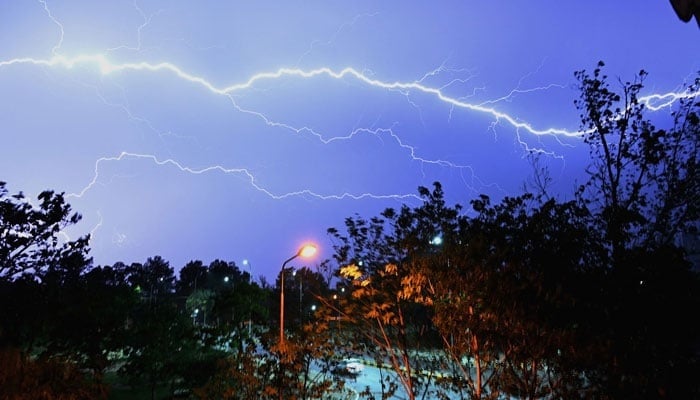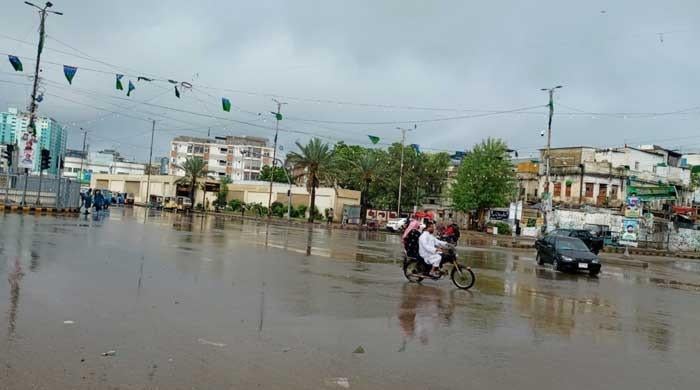How to stay safe from lightning strikes as Karachi braces for heavy rain, thunder
At least 65 people have died so far in storm-related incidents including lightning in Pakistan, say officials
April 17, 2024

You must have heard about incidents and damages caused by lightning during thunderstorms, but do you know what lightning is and how to stay safe from it?
According to meteorologists, lightning is a discharge of current between the atmosphere and the Earth, typically providing 220 volts (one ampere) in household lightning, while atmospheric lightning generates almost 30,000 amperes, indicating its intense nature.
Experts suggest that the interval between a lightning flash and the accompanying thunder of less than 30 seconds can indicate danger, and everything directly under the lightning strike is affected.
At least 65 people have died in storm-related incidents including lightning in Pakistan, officials said, with rain so far in April falling at nearly twice the historical average rate.
Heavy downpours between Friday and Monday unleashed flash floods and caused houses to collapse, while lightning killed at least 28 people.
The largest death toll was in northwestern Khyber Pakhtunkhwa, where 32 people have died, including 15 children, and more than 1,300 homes have been damaged.
"All the casualties resulted from the collapse of walls and roofs," Anwar Khan, spokesman for the province's disaster management authority, told AFP on Wednesday.
Precautionary measures
Meteorologists advise staying indoors during severe thunderstorms.
Lightning can also travel through metal pipes and phone lines, so it's advisable to avoid bathing or washing dishes during extreme thunderstorms, as current can pass through metal pipes in buildings.
The experts also recommend staying away from trees, fences, and poles on the road during severe thunderstorms and avoiding open areas under the sky.
Avoid using mobile phones during severe thunderstorms or only use them for emergency calls.
What to do if struck by lightning?
The meteorologists recommend that if someone is struck by lightning, nearby individuals should immediately call an ambulance and transfer the person to the hospital promptly.
The person struck by lightning may have burn marks at two places on their body, one where the lightning entered and the other where it exited.
According to the experts, there's no truth to the idea that lightning doesn't strike the same place twice.
PDMA alert
In the last six days, according to the Provincial Disaster Management Authority (PDMA), Khyber Pakhtunkhwa (KP) suffered the most, where the weather and lightning-related death toll reached 21.
In Sindh, Punjab, Balochistan, Azad Kashmir and Gilgit-Baltistan areas, 36 people lost their lives in the last five days in rain-related incidents, the NDMA added.
“In Khyber Pakhtunkhwa province 21 people have been killed and 34 injured in the last five days due to accidents caused by heavy rain,” the PDMA said in a report.
Due to continuous downpours in different parts of the northwestern province, 344 houses have been damaged due to the rain, the report said.
The PDMA said KP’s districts of Lower and Upper Dir, Khyber, Chitral Lower, Swat, Shangla, Mansehra, Malakand, Tank, Mardan and Karak were the province’s worst affected by the rains.
It said KP Chief Minister Ali Amin Gandapur had directed all the district administrations and departments concerned to provide medical assistance and relief to families affected by the rains.
What do meteorologists say?
"In April, we have observed highly unusual rainfall patterns," Zaheer Ahmad Babar, spokesperson for the Pakistan Meteorological Department (PMD), told AFP.
"From April 1st to April 17th, we experienced precipitation levels exceeding the historical average by 99 percent," he added, citing data from the past 30 years as a comparison.
Most of the country experienced a pause in the rain on Tuesday and Wednesday, but more downpours are predicted in the coming days.
"Climate change is a major factor behind these unusual weather patterns and above normal rainfalls, but it's not just Pakistan which is affected, the whole region is experiencing changes in temperature patterns," Babar added.
Pakistan is increasingly vulnerable to unpredictable weather patterns, as well as often destructive monsoon rains that usually arrive in July.
In the summer of 2022, a third of Pakistan was submerged by unprecedented monsoon rains that displaced millions of people and cost the country $30 billion in damage and economic losses, according to a World Bank estimate.











